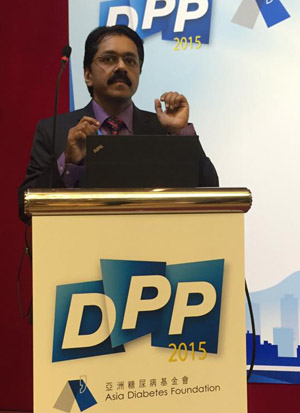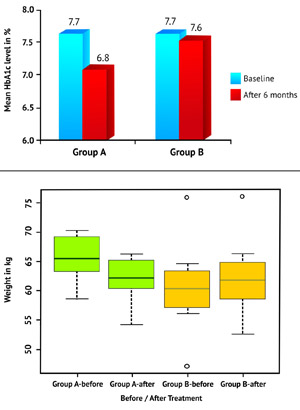
9. JDC Updates
Lectures and research presentations at diabetes conventions
- Dr.Jothydev Kesavadev lectured on ‘Understanding Glycemic Variability & Glycemic Profile with Ambulatory Glucose Profile’ where emerging evidence on Glycemic Variability as a major contributing factor for oxidative stress was discussed. The upcoming Freestyle Libre Pro is a new technology avoiding the use of a finger stick glucometer calibration. Freestyle Libre Pro provides retrospective data for 14 days. Ambulatory Glucose Profile which collapses CGM reading over 14 days which looks like a simple 24 hrs format. A 14 day CGM is found to be almost 95% predictive for a 1 month data. AGP also provides average glucose and details on low and high sugars. This was an invited lecture at the 6th World Congress of DiabetesIndia held from 9-12 April 2015 at Chennai, India.
- Dr.Arun Shankar, Unit Head and Consultant Diabetologist, JDC Trivandrum lectured on ‘What are the point to be highlighted by a Diabetologist in a clinic to educator and dietitian’. The success of treatment of diabetes is solely dependent on a team based approach. The Diabetologist as the head of the team should provide training to the team members with periodic reinforcement. Prescribing medications for diabetes does not translate to better outcomes in diabetes. It is impossible for the diabetes physician to spend hours with a single patient. He discussed that duty of physician to train the dietitian and diabetes educator to fulfil the responsibilities by imparting adequate professional training. This original research was presented at the 6th World Congress of DiabetesIndia held from 9-12 April 2015 at Chennai, India.
- Dr.Jothydev Kesavadev also lectured on ‘Clinical Significance of CGM: Adopting and Adjusting Therapies.’ CGM has evolved as a popular investigation in India. iPro2 is the device which provides retrospective data over 3-6 days. We have earlier presented data on the utility of CGM in diabetes and pre-diabetes as the visual appearance of the data serves as strong motivational tool for subjects to adopt stringent lifestyle modifications. iPro2 CGM is of immense use in T2DM patients for modifying lifestyles, adopting different treatment regimens, avoiding nocturnal hypoglycemia and addressing glucose variability. CGM should be utilised by clinicians in all eligible candidates provided there is time and dedicated team. This was an invited lecture at the 6th World Congress of DiabetesIndia held from 9-12 April 2015 at Chennai, India.
- Ms.Sunitha Jothydev lectured on ‘The Elderly Living Alone with Diabetes’ where challenges of managing diabetes in the elderly living alone were discussed. This original research was presented at the 6th World Congress of DiabetesIndia held from 9-12 April 2015 at Chennai, India.
- Dr.Jothydev Kesavadev’s 3rd lecture was on’ Long Term Consequences of Alternate Therapies for Diabetes- Myths vs. Realities.’ Diabetes is an ancient disease and so also is the Indian sub continent. Being a lifelong disease, which is expensive to efficiently manage and much more expensive if not efficiently managed, even educated patients get attracted to traditional systems of medicine presuming that they are more effective, cheaper and free of side effects. The efficacy and adverse effects of these alternate systems are largely unknown. The lecture explicitly discussed the merits and demerits of Alternate or complimentary therapies. This was an invited lecture at the 6th World Congress of DiabetesIndia held from 9-12 April 2015 at Chennai, India.
More Pictures
 Dr. Jothydev Kesavadev was invited to lecture on available and evolving technologies and how they can be effectively utilised to bring down the exhaustive cost of diabetes care.Diabetologists from Hong Kong, Macau, Taiwan, Korea, Singapore, Thailand, Malaysia, Philippines, China and neighbouring Asian countries attended the diabetes prevention forum.Diabetes: Preventing the Preventables(DPP) convention was organized by Dr. Juliana Chan, Chief Executive Officer, Asia Diabetes Foundation,The Chinese University of Hong Kong.
Dr. Jothydev Kesavadev was invited to lecture on available and evolving technologies and how they can be effectively utilised to bring down the exhaustive cost of diabetes care.Diabetologists from Hong Kong, Macau, Taiwan, Korea, Singapore, Thailand, Malaysia, Philippines, China and neighbouring Asian countries attended the diabetes prevention forum.Diabetes: Preventing the Preventables(DPP) convention was organized by Dr. Juliana Chan, Chief Executive Officer, Asia Diabetes Foundation,The Chinese University of Hong Kong.
- JPEF Kollam 2015
Dr. Jothydev Kesavadev lectured on 'High PPG load in Indians and the scope of mid-mixes- focus on mid switch' at the Jothydev's Professional Education Forum CME 2015 on 9th May at Hotel Raviz Kollam. Dr.Amrithlal(Nair's Hospital) and Dr.John Zachariah(Benziger Hospital) were the chairpersons. Dr.Johnny Kannampilly(Lakeshore Hospital) and Dr.Balachandran.V(Nair's Hospital) were the co-speakers. Mementos were handed over to speakers and chairpersons and certificates were provided to delegates.
More Pictures
- Insulin Pumps 'For Life' Vs Insulin Pumps 'For Luxury'-the Indian Experience in Type 2 Diabetes.
 This original research from Jothydev's Diabetes Research Centre,Trivandrum Dia Care(Dr. Banshi Saboo, Ahmedabad) and Joshi Clinic, Mumbai was presented at AACE 2015 Annual Meeting in Nashville in May 2015 by Dr. Shashank Joshi.
This original research from Jothydev's Diabetes Research Centre,Trivandrum Dia Care(Dr. Banshi Saboo, Ahmedabad) and Joshi Clinic, Mumbai was presented at AACE 2015 Annual Meeting in Nashville in May 2015 by Dr. Shashank Joshi.
Insulin pumps started getting popular in India since 2004. Unlike in the West, 80% of the pump users in India are insulin requiring type 2 diabetes subjects. With increasing longevity majority of subjects with type 2 diabetes ultimately require multiple doses of insulin daily to sustain life. Pumps have gained popularity with the evidence and experience as an advanced insulin delivery device, superior to conventional syringes and pens, as an advanced technology offering improvement in QOL, alleviation of neuropathic pain and flexibility of lifestyles.
Usual initial pump training provided is on basic functions like basal, bolus & suspend. Advanced functions like insulin sensitivity factor, insulin carb ratio, bolus wizard, temporary basal & dual/square wave bolus are taught only after 1-2 months when they are more comfortable and less confused. We identified 2 groups of pump users with type 2 diabetes from our electronic medical records – Group A (n = 123) who used pumps for life and Group B( n=31) who used pumps for luxury. Group A used new knowledge judiciously and intelligently whereas group B misused it for eating and pumping more. Average baseline A1c in both groups was 7.7%.
Six months after advanced training. 'A' had mean A1c 6.8% and 'B' had 7.6%. In 'A', weight reduction was around 5.5% (p<0.0001, CI 1.6) compared to 'B' with a weight gain of 3.0% (p=0.12) from the baseline. 'A' had a reduction in total daily dose of insulin (TDD) by 6-8 IU compared to increase in 'B' by 8-10 IU. Thus, 'A' had significant reduction in weight, TDD, and HbA1c compared to 'B'.
'A' had followed the instructions on diet,exercise,telemedicine follow up and along with it utilised the extra pump functions judiciously for sustaining life ("Pumps for Life") whereas B exploited the features like bolus wizard, temporary basal, extended bolus etc for extra doses of insulin in accordance with food intake ("Pumps for Luxury").
We recommend identifying patient characteristics and modulating initial and advanced insulin pump training sessions accordingly with help of dietitian, diabetic educator, psychologist etc., customizing their sessions to meet individual challenges so as to prevent inadvertent misuse of an advanced gadget for insulin infusion.
| Read More |
For enquiries info@jothydev.net.
Please visit: jothydev.net | research.jothydev.com | diabscreenkerala.net | jothydev.com/newsletter
